Macroscope Board Game Overview
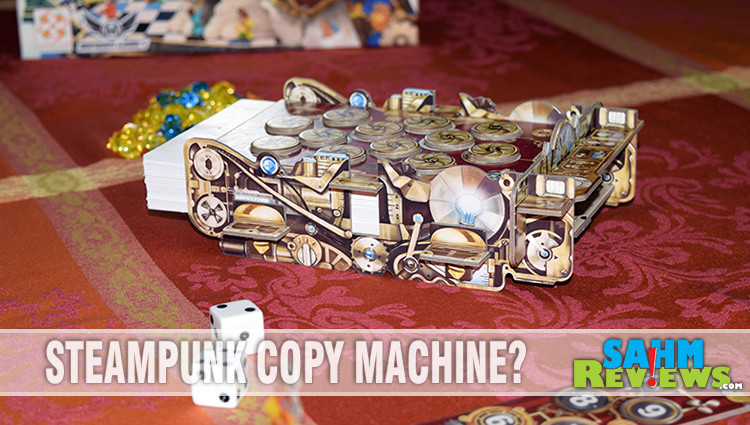
If you’ve been a regular reader, you know I have a thing for TV game shows. You may recall my story about how my Father-in-Law was asked to “Come on down!” Or perhaps you remember how excited I was about getting to go on the set of Family Feud. There was seldom a game show that I didn’t enjoy and watched everything from the original The Wheel of Fortune to silly ones like Supermarket Sweep. When The Game Show Network launched on cable many years ago, I rediscovered some of my favorites (“No whammies, no whammies, no whammies. STOP!”) and found others that I had completely forgotten about. In an odd way, it was a little slice of heaven for me.
Every once in a while something will happen or I’ll see something that reminds me of a gameshow that I had totally forgotten about. When we saw a giant version of Macroscope on display at the Mayday Games booth at Origins Game Fair, I had flashbacks of a game show. While the name eludes me, I remember that contestants took turns uncovering pieces on a screen in hopes of deciphering the puzzle underneath. The less tiles they flipped, the better. That’s as much as I remember, but it was enough to make the game play of Macroscope easy to pick up on.
While you can actually solve the puzzles by yourself, Macroscope game is designed for 2-6 players. The 3-D “board” is assembled with the removable cogs placed on top of the unit to cover all the windows. These tokens are numbered from one to six and should be placed randomly each time. The stack of puzzles is placed inside and the top one removed. An active player is selected and the Macroscope is placed using the arrow as reference to the orientation of the hidden image. The arrow should be pointing away from the active player.
Players begin the game with two yellow crystals. These crystals are the currency as well as end of game victory points. I’ll go over that more in a minute. The rules are simple, but difficulty in deciphering the puzzle will change each time. On your turn, roll both the dice the you may remove one of the tokens with a number matching one of the dice. After this step, you have three options: Make a guess, remove a token matching the number on the second die or pass the turn to the next person. If you choose to remove the second token, your next options are either to guess or pass to the next person.
If in either stage of your turn, you choose to make a guess, you simply announce to the other players that you want to guess then proceed to tell what you think the hidden image is. If other players think you are incorrect and want to challenge you, they can. Starting with the one with the least amount of victory points, they simply pay you two yellow crystals and say out loud what they think the answer really is. As I mentioned before, these yellow crystals aren’t just victory points, but they serve as currency. If you don’t have two crystals to pay the active player, you cannot challenge them! Once everyone has determined if they are challenging or not, the closed windows are counted and the picture revealed. The player who guessed correctly received victory points (crystals) equal to the number of covered spaces. An incorrect guess means you’re paying that many instead!
Let’s be honest though. Depending on what dice are rolled and whether or not the picture is even recognizable, you may not feel comfortable making a guess and instead choose to pass. If so, take yellow crystals equal to the number of windows you uncovered. At this point, any other player can opt to make a guess using the same rules as when they challenge. If nobody chooses to guess, the next active player rolls the dice and the process continues until the picture is guessed. If you’re playing with someone who guesses early (and correctly), don’t be sucked into the idea that you need to guess early also. Speaking from experience, if you guess incorrectly, it will leave you with no crystals which means you can’t guess during other people’s turns.
The game continues for 10 rounds, tracked based on the number of pictures – not the number of active players. What this means is that it will take several games before you’ve revealed all the images on the double-sided picture cards. While eventually you will see all the cards, it is going to take quite a while before that happens! You can get multiple hours of entertainment for on Amazon or pick up a copy direct from Mayday Games.
We’re extremely excited that Mayday Games has offered for us to give away a copy of the Macroscope to one of our readers. Unlike our normal giveaways that are open to U.S. entrants only, they have agreed to handle prize fulfillment worldwide! Hop over to Twitter or Facebook and let Mayday Games know what you think of Macroscope and check out what promotions, sales and upcoming game releases.
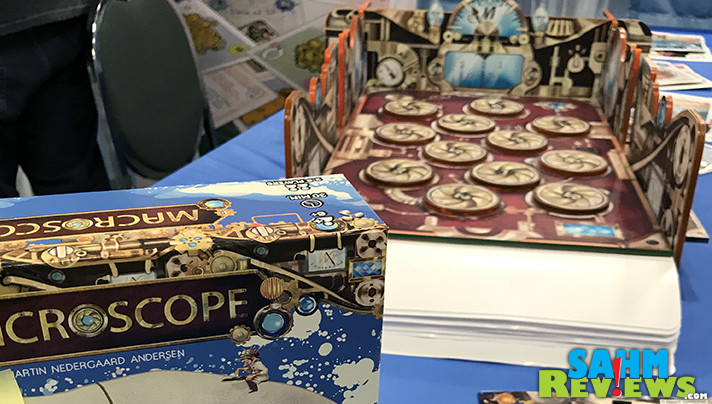
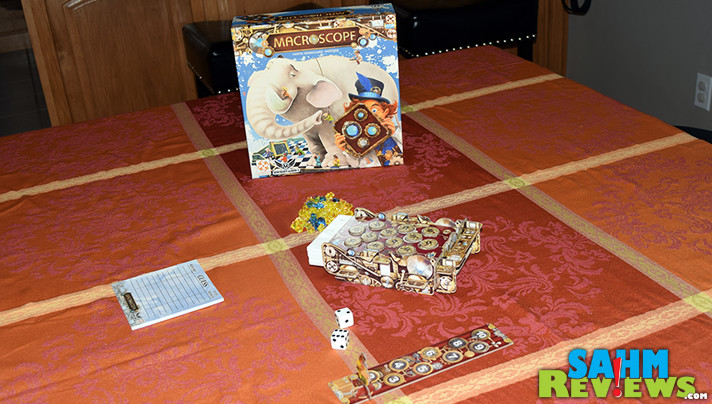
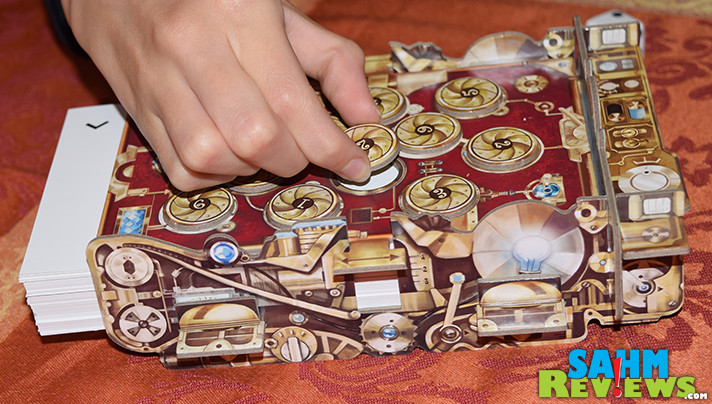
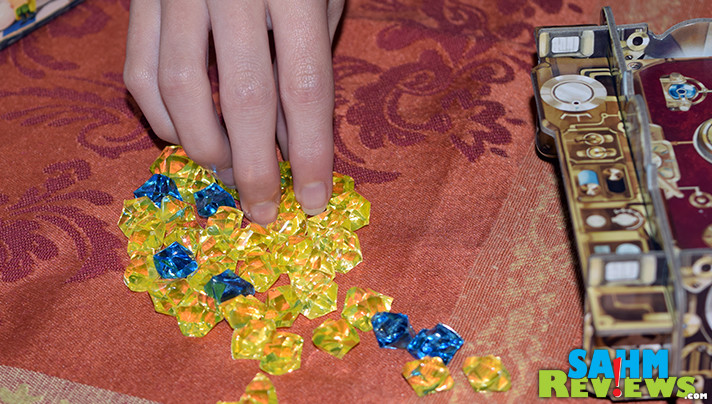
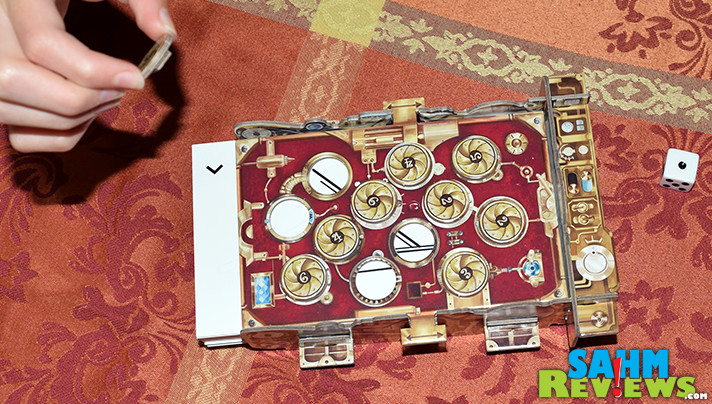
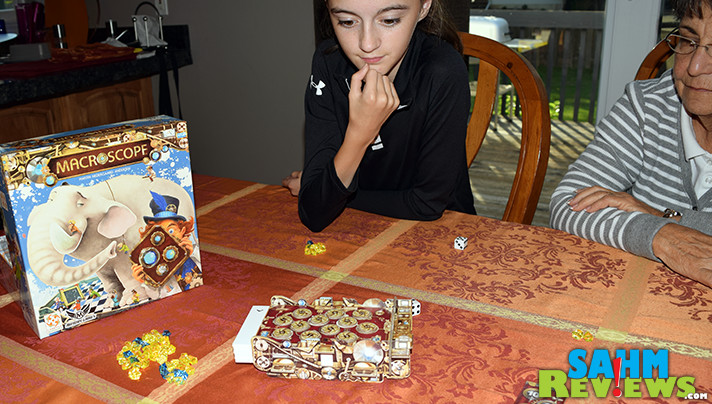



I’m normally only OK at these kinds of puzzles, but this is the coolest looking thing-a-ma-jig I’ve seen in a long time.
I am not very good with puzzles. My nephew is.
I can be but I would rather work with a team 🙂
i’m pretty good with puzzeles
Yes, I would like to believe that I am good at deciphering puzzles.
Yes. I am good at deciphering puzzles.
This looks pretty fun! I wonder if my 7 year old would be able to play? I don’t think you mentioned an age range in the review, though maybe I missed it.
I’m also a game show geek, though I usually like the classic ones better. My husband is even more a geek about them than me, so it’s fun to watch them together. I still love catching Let’s Make a Deal or Price is Right in the mornings!
varies, math and logic puzzles more than riddle types
I’m pretty good at deciphering puzzles. I’ve been stumped before though.
I am pretty good at deciphering puzzles.
I’m pretty good at puzzles, I enjoy working through riddles or logic puzzles and live playing along with catchphrase so figure this would be great to try!
You asked if we are good at deciphering puzzles. It depends on the type.
Usually I’m Pretty good at deciphering puzzles.
It depends on what type of puzzle it is. This one would really be a challenge!
No!! Not good at all…
I’m pretty good at puzzles, but enjoy working with my husband or kids on them together and bouncing ideas off each other.
I’m good at puzzles:)
I am somewhat ok. There are times where I need help depending on the puzzle.
Yes, I am a huge fan of puzzle games. It’s just fun to spend the time to decipher the puzzle in order to find the solution.
I used to be much better at puzzles when I was younger, but I don’t have as much patience as I did back then.
Depends what kind of puzzle
I am very good at deciphering puzzles I think.
I am pretty good at deciphering puzzles.
I am average at deciphering puzzles. My husband is better at it.
I’m good at deciphering puzzles, my whole family is. We don’t stop until we’ve deciphered a puzzle.
I am the WORST at deciphering puzzles. Which definitely puts me at a disadvantage in this family, where my hubby, son & daughter are the BEST at it!
I’m average at deciphering puzzles. It depends on which kind of puzzle it is.
Yes, I am very determined and swift.
I love puzzles and puzzle games. This looks perfect for me!
I am not good at good at deciphering puzzles
I’m not that good at puzzles. Our family loves to play games, my son-in-law is the one that is really good at puzzles!
I’m pretty decent at solving puzzles and this game would be awesome to try myself once again!
I’m pretty good
Am I good at puzzles?
I thought I was… but lately I find far too much slipping past me. Traditional puzzles though, logic and riddles and words and numbers and spacial relations and things, I got it.
Yes, I think so.
Yep, I guess I am.
I am not very good at deciphering puzzles
I am pretty good at deciphering puzzles. However, sometimes it can take me a very long time to decipher them. Thanks for the fantastic opportunity to win!
I am good at deciphering some puzzles, but I fail at riddles.
I’m good sometimes at deciphering puzzles it just depends on how hard they are.